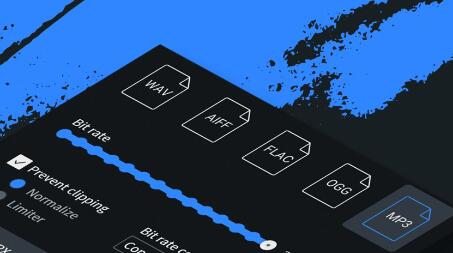Choosing the best audio file format depends on various factors including the intended use, quality requirements, and storage considerations. Here’s a comprehensive overview of the most popular audio file formats, their advantages, and disadvantages.
1. MP3 (MPEG Layer Audio 3)
Overview
MP3 is perhaps the most widely recognized audio format due to its balance between file size and audio quality. Developed by the Moving Picture Experts Group (MPEG), it utilizes lossy compression, meaning that it reduces file size by eliminating some audio data.
Advantages
File Size: MP3 files are relatively small, making them ideal for storage and streaming.
Compatibility: Almost all devices and media players support MP3 files.
Customizable Quality: You can choose various bit rates (e.g., 128 kbps, 192 kbps, 256 kbps, 320 kbps) to balance between file size and quality.
Disadvantages
Lossy Compression: Some audio data is lost during compression, which can affect sound quality, especially at lower bit rates.
Not Ideal for High-Fidelity Audio: For audiophiles or applications requiring high fidelity, MP3 might not suffice.
Best For
General listening on portable devices
Streaming services
Applications where file size is a concern

2. WAV (Waveform Audio File Format)
Overview
WAV files are uncompressed audio files that provide high audio quality. Developed by Microsoft and IBM, WAV files maintain the original audio fidelity but come with larger file sizes.
Advantages
High Quality: WAV files are lossless, preserving all original audio data.
Simple Structure: The format is straightforward, making it easy to work with in various audio editing applications.
Professional Use: Widely used in professional audio recording and editing.
Disadvantages
Large File Sizes: Due to lack of compression, WAV files can be quite large, which can be impractical for portable devices or limited storage.
No Metadata Support: Limited ability to include metadata like artist names or album titles.
Best For
Professional audio production
Archiving high-quality audio
Situations where file size is not a constraint
3. FLAC (Free Lossless Audio Codec)
Overview
FLAC is a lossless audio compression format that reduces file size without losing any quality. It is ideal for audiophiles who want to maintain the original audio fidelity while still benefiting from some compression.
Advantages
Lossless Compression: Maintains the original quality of the audio.
Metadata Support: Includes support for extensive metadata and album art.
File Size: Offers a good balance between quality and file size, though files are still larger than MP3.
Disadvantages
Compatibility: While FLAC is supported by many devices and software, it’s not as universally compatible as MP3.
File Size: Although compressed, FLAC files are still larger compared to lossy formats like MP3.
Best For
Audiophiles and high-fidelity audio enthusiasts
Archiving audio in high quality
Applications where compatibility with various devices is less of a concern
4. AAC (Advanced Audio Codec)
Overview
AAC is a lossy compression format similar to MP3 but with improved efficiency and sound quality. It is used by many streaming platforms and modern devices.
Advantages
Better Quality at Lower Bit Rates: Provides better sound quality than MP3 at the same bit rate.
Wide Compatibility: Supported by most modern devices and media players, including Apple products.
Efficient Compression: Smaller file sizes compared to MP3 with comparable or better sound quality.
Disadvantages
Lossy Compression: Like MP3. it sacrifices some audio data for reduced file size.
Not Universal: Although widely supported, it may not be as universally compatible as MP3.
Best For
Streaming services
Modern devices and media players
General listening where sound quality is important but file size is also a concern
5. ALAC (Apple Lossless Audio Codec)
Overview
ALAC is Apple’s lossless audio compression format, providing high-quality audio similar to FLAC but optimized for use within Apple’s ecosystem.
Advantages
Lossless Compression: Maintains the original audio quality without any loss.
Integration with Apple Products: Works seamlessly with Apple devices and software.
Metadata Support: Like FLAC, ALAC supports metadata and album art.
Disadvantages
Limited Compatibility: Mainly compatible with Apple devices and software, with less support on non-Apple platforms.
File Size: Larger files compared to lossy formats.
Best For
Users within the Apple ecosystem
High-quality audio archiving for Apple devices
Situations where compatibility with non-Apple devices is not a concern
6. Ogg Vorbis
Overview
Ogg Vorbis is an open-source, lossy compression format that provides good audio quality at lower bit rates compared to MP3.
Advantages
Open Source: Free to use and modify.
Good Quality: Generally better sound quality at the same bit rate compared to MP3.
File Size: Smaller files with decent audio quality.
Disadvantages
Compatibility: Less widely supported compared to MP3 and AAC.
Less Popular: Not as commonly used or recognized as other formats.
Best For
Users looking for an open-source alternative to MP3
Situations where file size and quality are a concern but compatibility is less important
Conclusion
Each audio file format has its own strengths and weaknesses. The “best” format depends on your specific needs:
For general use and broad compatibility: MP3 is a safe bet.
For professional audio work: WAV provides the highest quality.
For high-fidelity audio with some compression: FLAC is a strong choice.
For streaming and modern devices: AAC is efficient and widely supported.
For Apple ecosystem users: ALAC is optimal for lossless audio.
For an open-source option: Ogg Vorbis offers good quality and compression.
Understanding the purpose of the audio file, whether it’s for professional production, casual listening, or streaming, will guide you in choosing the format that best fits your needs.
About us and this blog
Panda Assistant is built on the latest data recovery algorithms, ensuring that no file is too damaged, too lost, or too corrupted to be recovered.
Request a free quote
We believe that data recovery shouldn’t be a daunting task. That’s why we’ve designed Panda Assistant to be as easy to use as it is powerful. With a few clicks, you can initiate a scan, preview recoverable files, and restore your data all within a matter of minutes.

 Try lt Free
Try lt Free Recovery success rate of up to
Recovery success rate of up to









